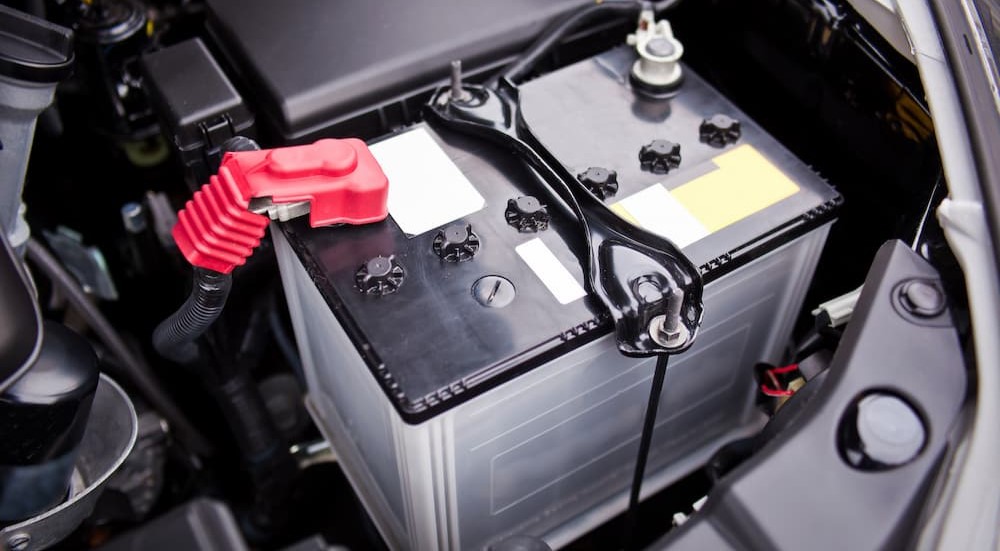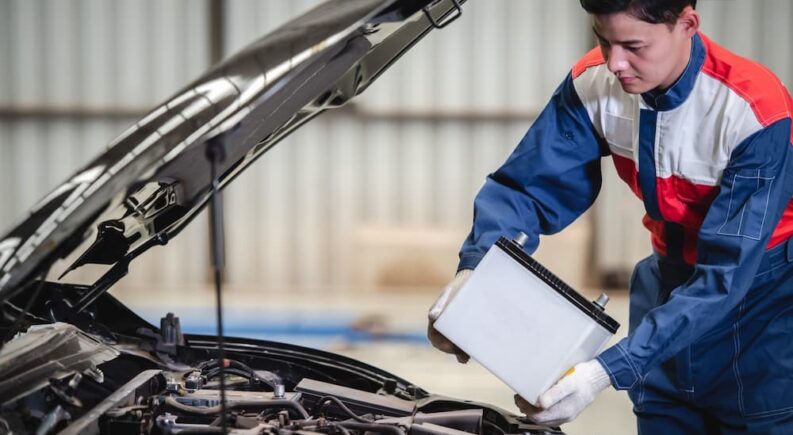Every year, one common automotive issue will lead more than two million drivers to place a call to roadside assistance. While lockouts, flat tires and empty gas tanks rank among the top culprits, it’s actually battery-related problems that have services like AAA pulling overtime. Keeping your car’s battery charged is usually a pretty easy task if you adhere to some basic care and maintenance practices, but even the most experienced driver has been known to slip up from time to time. The average car battery is designed to last anywhere between three to five years, but there are plenty of forces conspiring to rob you of some valuable service life. From corrosion and extreme temperatures to bad wiring, power-hungry accessories, and alternators that are on their last legs, it’s all too easy to put some undue stress on your car battery. If you’re looking to avoid that dreaded call to roadside assistance, follow along as we outline some common causes of a drained battery and offer some solutions that’ll keep you all juiced up.
Headlights
Sometimes, a dead or drained battery can be a real mystery; other times, it’s bright as day…or at least as bright as your headlights. Leaving your headlights on can easily drain a battery, especially if they’ve been on all night. Many newer models have addressed this common issue with a feature that’ll automatically turn off the lights after a set period of time, but for older vehicles, this sort of slip can leave you scrambling for jumper cables or pulling out your AAA card.
How to Address: Double-check your headlights before locking your car. If this becomes a chronic problem, try leaving yourself a small sticky note or some other type of reminder that you’ll be sure to see before you go to bed. If you just can’t kick the habit, consider investing in a battery jumpstart kit for as little as $50.
Parasitic Drain
Neglected headlights are one of the easiest ways to deplete your battery, but they’re really just the most obvious form of something known as parasitic drain. From interior lights and the radio to security systems and USB-powered accessories, there are all sorts of gadgets conspiring to drain your battery. Normally, there’s more than enough power to go around, but neglecting to extinguish interior lights like the dome light, map lights, or glove compartment light can result in a weak or nonexistent start, thanks to a dead battery. In some cases, shorts or bad relays within the vehicle’s electrical system can have the same effect.
How to Address: Before putting your car, truck, or SUV away for the night, give the cabin a quick once-over to ensure that no lights have been left on. Also, make sure the doors and trunk are fully latched, as these will often cause the vehicle’s dome light to stay illuminated if left even slightly ajar. If you’re encountering persistent parasitic drain issues but don’t see any obvious lights or accessories that could be responsible, it’s time to whip out the voltage tester or take your vehicle to a qualified mechanic to help pinpoint the issue.

Bad Alternator
This might come as a surprise to some of the less mechanically inclined drivers out there, but your car battery isn’t actually responsible for powering most of the vehicle’s electrical systems. This is actually the duty of the alternator, which converts energy from the engine into an electrical charge used to power everything from the radio to the headlights. The alternator also recharges the battery when the vehicle is in motion, topping it off and giving it enough juice to activate the starter motor when you turn the key in the ignition. If your alternator is acting up, it won’t produce enough power to recharge the battery, resulting in slow starts or no starts at all. Other signs of a faulty alternator include dim or flickering lights, malfunctioning accessories, a distinctive whirring noise, or the smell of burning rubber or wires. In some cases, a bad alternator will also cause the dashboard’s battery light to illuminate.
How to Address: A bad alternator usually needs to be addressed by a mechanic. In most cases, you’ll be looking at a full replacement. This job will usually cost a few hundred dollars, including both parts and labor. Some drivers might go the life of their vehicle without experiencing a faulty alternator, but failures are not unheard of. The typical alternator will last between 80,000 and 150,000 miles or around seven years on average.
Inactivity
A car battery is designed for consistent use, which can present some real problems when it comes to seasonal vehicles or those that have simply been sitting around for a while. On average, a battery will maintain a charge for one to two months, but after that point, it can easily fall below the sort of voltage you need for a smooth, consistent start. This is mainly due to the parasitic drain phenomenon we mentioned earlier, with features like security systems drawing a small amount of power even when the vehicle isn’t in use. When a car is being regularly driven, this small amount of drain is offset by the alternator, which helps to keep the battery at an optimal power level.
How to Address: There are a number of ways to keep a battery charged while a vehicle isn’t being used. Many drivers will opt to run their car for five to 10 minutes at least once a week. Taking a short trip around the neighborhood can have the same effect and will also help to keep the tires from losing their shape. You could also opt to remove the battery altogether, which will put a stop to the type of parasitic drain that can lead to many problems. By storing a battery in a well-ventilated area that remains at room temperature, drivers can extend the storage time from two months to as many as six months. Alternately, drivers can purchase a battery tender, which plugs into any wall outlet and feeds the battery a small trickle charge that’ll keep it nice and fresh.
Battery Terminals
In order to work its best, it’s important that your battery is actually connected to your vehicle. This might sound pretty obvious, but there are actually a number of issues that can endanger this connection. For instance, your battery cables can shake loose from the battery, especially if you regularly engage in bumpy off-road driving. It’s also possible for your battery’s terminals to become so corroded that the cables can’t make a clean connection. From high temperatures to leaking fluid and battery age, there are a number of factors that can lead to battery corrosion. That crusty layer of white, green, or blue build-up can stop power from effectively transferring between the battery and vehicle and should always be addressed ASAP.
How to Address: Battery corrosion might look scary, but it’s actually pretty easy to deal with. Disengage the battery and start by scrubbing the terminals with a wire brush. Once you’ve removed the obvious corrosion, give the terminals a quick pass with a half-water/half-baking soda mixture that’ll help to address any lurking chemicals. Fixing a loose connection is even easier. Just readjust the battery cables and make sure they’re securely fastened to the terminals. If they’re past their prime, a set of replacement battery cables can be found for as little as $15 to $20.
Short Drives
As we mentioned above in the section on alternators, a car battery is designed to deliver one big burst of power to the starter motor. This can be anywhere between 150 to 600 amps of power, which can be a big ask for a battery. Those amps are replenished by the alternator as the vehicle is driven, but if you’re prone to taking lots of short trips, the battery might not be receiving enough power to get back up to full capacity before you ask it to start the car again.
How to Address: Sometimes, it’s hard to avoid taking short trips, but in many cases, drivers can try to batch their errands to ensure that the battery isn’t working overtime. Planning your vehicular excursions isn’t just good for the battery; it’s better for your vehicle in general as it promotes overall efficiency and performance.

Extreme Temperatures
Just like the batteries found in your phone, drone, or remote control, 12-volt car batteries are not a fan of extremely high or low temperatures. Batteries are designed to operate in a specific temperature range. While they’re not going to immediately fail when things get too hot or cold, their capacity can be drastically reduced. When the thermometer hits the freezing point, a battery can lose a third of its capacity, sinking to as much as two-thirds as the mercury continues to drop. Hot summer temps can actually increase battery power but will dramatically shorten its lifespan. Corrosion is also accelerated when a battery is exposed to high temperatures, which is why it’s always a good idea to park in a shaded area when possible.
How to Address: Keeping your vehicle in a garage is one of the easiest ways to avoid exposing the battery to extreme temperatures, but that’s not an option for many drivers. In some cases, the solution comes down to starting with the right battery in the first place. If you live in an area with consistently high or low temperatures, many experts recommend investing in an absorbed glass mat (AGM) battery. These batteries use a slightly different formula than the typical lead-acid design and are better able to withstand deep discharges and high temps. Their unique chemistry means they’re also more resistant to freezing, though they’re often twice as expensive as a conventional lead-acid battery.
Battery Age
A battery is just as susceptible to old age as the rest of us. Over time, a battery starts to lose its effectiveness, resulting in lower capacity, corrosion, and other issues that can impact performance. In most cases, a car’s battery will last anywhere between three and five years, but it really depends on individual driving habits and how well it’s been maintained. If you see a noticeable drop in performance or find yourself frequently jumpstarting your battery, it’s a good sign that it’s not long for this world.
How to Address: If you’re trying to squeeze as much time as possible out of your battery, it’s important to develop some good habits. We’ve covered some of these above, but in general you want to avoid exposing the battery to extreme temperatures and avoid shorter trips where the alternator doesn’t have enough time to charge the battery. Letting a vehicle sit idle for too long or performing an excessive amount of jumpstarts can also impact a battery’s longevity.
Develop Good Battery-Saving Habits
There’s nothing quite as frustrating as going to start your car only to be met with that dreaded clicking noise and an engine that just won’t turn over. Luckily, this scenario is pretty easy to avoid if you develop some good battery-saving habits and keep a few simple tips in mind. Avoiding extreme temperatures and short drives, keeping your battery terminals free of corrosion, and using a battery tender during long periods of inactivity are all important when it comes to long-term battery health, but failing to switch off headlights or interior lights is usually the most common cause of a dead battery. A bad alternator is a little tougher to avoid, but if you know which symptoms to keep an eye out for, it’s usually easy to catch the problem before it goes too far. A dead battery can throw off your whole day, making you late for work or delaying important errands, but keeping your battery charged is often just a matter of mindfulness.

